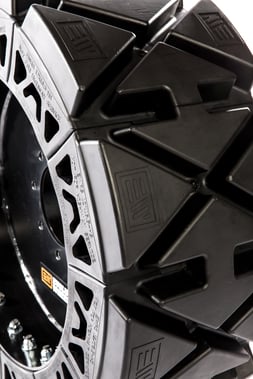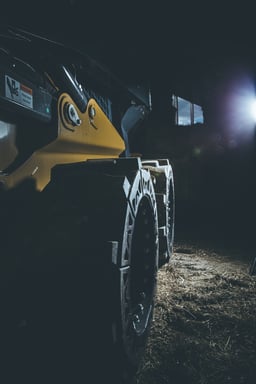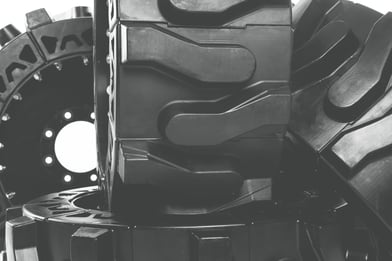Skid steer loaders play a crucial role in many industries, including construction, demolition, mining, landscaping, waste management, and more. However, when equipped with improper skid steer tires, skid steers are susceptible to many problems that can lead to wasted time and money.
When purchasing new skid steer tires for your loader, consider airless skid steer tires over standard pneumatic skid steer tires. Airless skid steer tires outperform pneumatic skid steer tires in many ways and offer great benefits to your job site.
No Risk of Flats with Airless Skid Steer Tires
One of the biggest problems pneumatic skid steer tires face is flats. Because they are filled with air, any sharp object like a piece of scrap metal, a landscaping utensil, or a jagged rock can puncture a pneumatic skid steer tire. This will render a loader useless until it’s fixed. While punctures in pneumatic skid steer tires can be filled, a puncture often requires tire replacement. This means whatever potential work life left in the original tire is lost.
On the other hand, airless skid steer tires are not susceptible to punctures and flats as they are made of solid rubber. This eliminates the stress and hassle of stopping work, having to fix the flat, or having to purchase and replace a tire to keep the job on track.

Extended Wear Life
Another problem pneumatic skid steer tires often face is being worn down. This is particularly true for skid steers operated in harsh environments such as mines, demolition, or construction sites. Rough terrain quickly wears down the tread of pneumatic skid steer tires which means these tires must be replaced for work to continue safely and efficiently.
Airless skid steer tires are crafted from high-quality rubber compounds. As such, it takes a lot more to wear the tread of these tires. Airless skid steer tires can withstand heavy use for longer periods, meaning you'll be able to get more work accomplished with less frequent tire replacements.
While it is generally more expensive to purchase airless skid steer tires upfront, it is important to remember that their longer wear life means they won’t need to be replaced as often. Having to replace cheaper pneumatic skid steer tires often, you'll see that airless skid steer tires are much more worth their initial expense in the long run.
Better Traction
Good traction is essential to safety and efficiency when operating skid steer loaders. As the tread of pneumatic skid steer tires wears down, they begin to lose traction and make operation difficult and potentially dangerous.
Because of their sturdy, solid construction, airless skid steer tires are heavier than their air-filled counterparts. This creates a more uniform tread surface and provides your skid steer loader with better traction. Additionally, because of their increased resistance to wear and damage, the tread on airless skid steer tires lasts longer. This means your skid steer will operate with exceptional traction for a much longer time.
Reduced Downtime

Downtime occurs when no work is completed. Due to their susceptibility to flats, damage, and wear, and the need to swap out flat or damaged tires for replacement ones, pneumatic skid steer tires are often huge downtime producers.
When a tire needs to be replaced, your skid steer loader cannot operate until the tire is replaced. Purchasing and installing a replacement or repairing a puncture or other damage wastes time that could be spent finishing more work. When you aren't working, you lose money.
Because airless skid steer tires are immune to punctures and flats, and require replacement much less often, they greatly reduce downtime on the job site. Reducing downtime means you'll get paid for more working hours and complete projects within a shorter timeframe.
When purchasing new tires for your skid steer loader, consider equipping it with durable, high-quality solid skid steer tires. These tires provide an exceptional ROI and keep your loader working until your job is complete.
To learn more about airless skid steer tires visit the Airless Skid Steer Tires page from Evolution Wheel.


